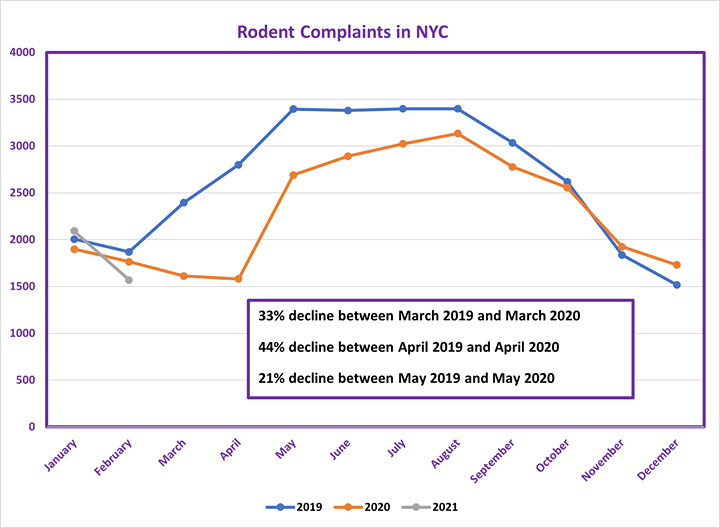A. TL,DR In the immediate aftermath of the March 2020 safer-at-home orders and abrupt changes in restaurant activity, New York City saw a sizeable reduction in rodent complaints, but that decline was short lived.
I’ll confess: this Nerdy Girl (Lauren) is terrified of rats. And early in the pandemic, there were multiple super freaky stories about rats doing the stuff of nightmares.
For example, take this story about hungry aggressive rats cannibalizing other rats.
Or this one, in which rats moved into the engines of unused vehicles parked on city streets.
How about this article from later in the summer, after some restaurants had reopened, when rats were crawling over the feet of outdoor diners.
I wanted to know if any of these disruptions to the urban rat behaviors had a lasting effect. I spoke with Caroline Bragdon, Director of Neighborhood Interventions in the Bureau of Veterinary and Pest Control at the NYC Health Department. Ms. Bragdon provided the monthly numbers for rodent complaints in NYC over the past 26 months. As shown in the figure, by following the rodent complaint count trajectory over the year in 2019, we can see that in a non-pandemic year, starting in March there is usually an increase in rodent complaints that peaks in the summer.
We did not see this March bump in rodent activity in 2020. Instead, starting with New York’s safer-at-home orders, there were 33%, 44%, and 21% fewer rodent complaints during March, April, and May, respectively, compared to the same month in the previous year. By the end of the pandemic summer, the number of rodent complaints was comparable to the previous year, a pattern that has continued through to early 2021.
While a count of rodent complaints is an imperfect measure of rats in the city, the drop in complaints was likely due to restaurants being closed, leaving less food available for rats to consume. In addition, with fewer people leaving their households, there were fewer people there to observe the rats in action.
Ms. Bragdon reported that New York City also measures rat activity by keeping track of the percent of properties that fail inspection in each neighborhood. They also count rat burrows as a strategy to assess the severity of infestations on some large properties.
If, like me, you’re not a fan of Rattus norvegicus you can review this link for easy tips on how to reduce rodent activity in your vicinity.



